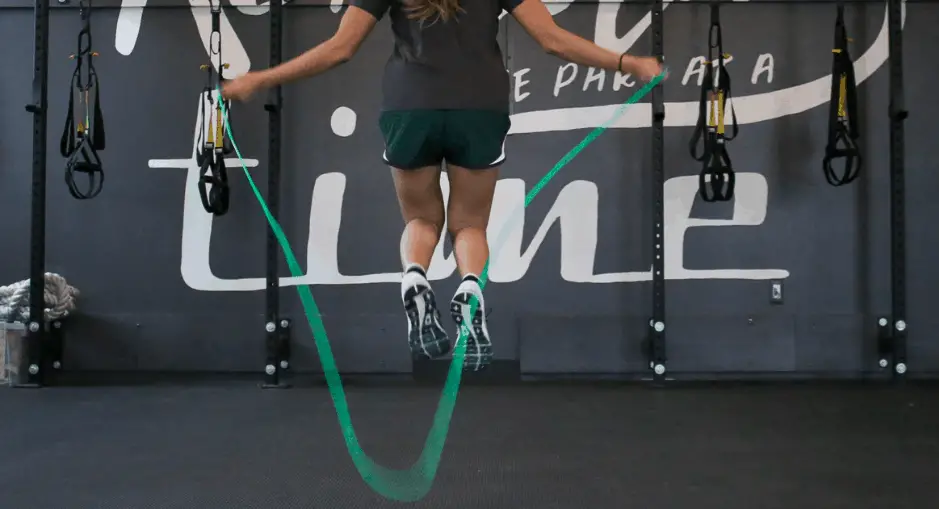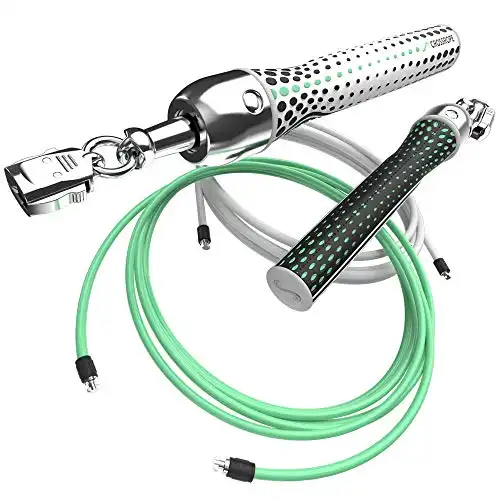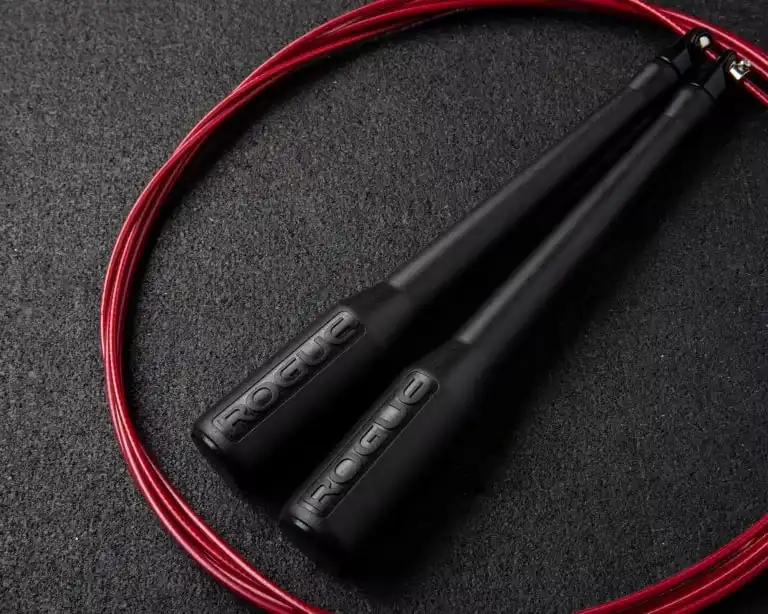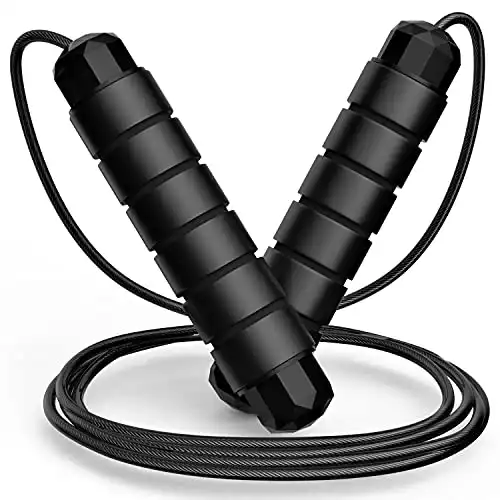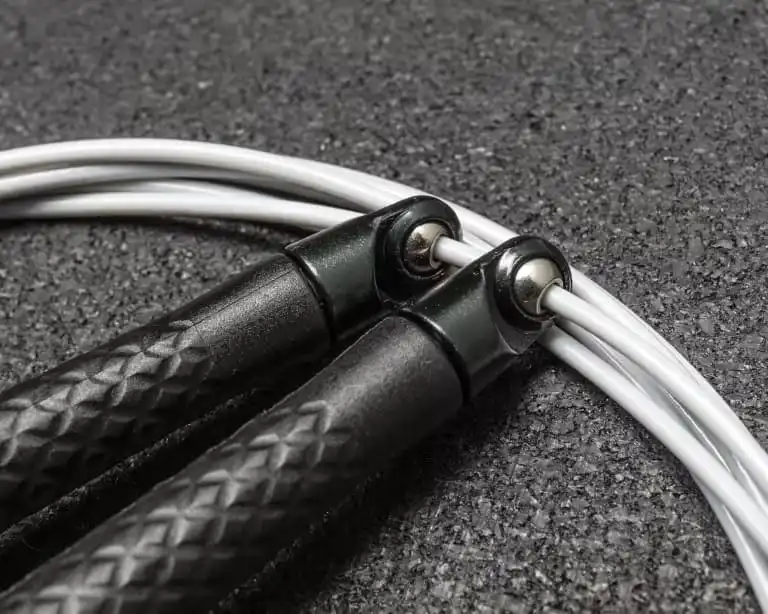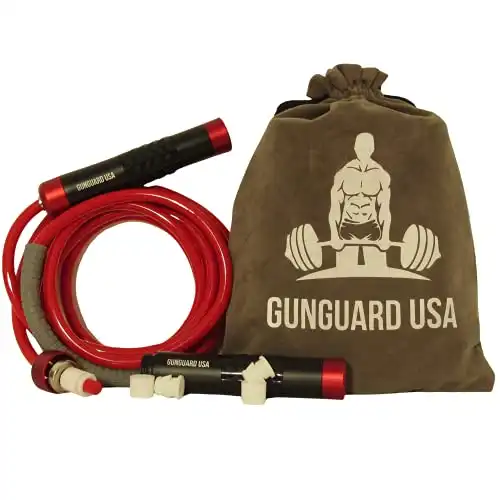If you’ve been searching around to find the best CrossFit jump rope for your workouts, you’ll have undoubtedly discovered what a challenge it can be.
Generally used to practice double-unders, jumping rope can prove to be an excellent way to engage multiple muscle groups without having to spend a lot on expensive, space-consuming equipment.
Though you undoubtedly already know this, you probably also know that trying to pick just one rope out of the countless options available to you can be enough to make you want to forget the whole thing and head to your local CrossFit gym for a workout instead.
The good news is that it doesn’t have to be this way.
For the purposes of this guide, we put scores of 2022’s best-selling CrossFit jump ropes through their paces, testing each one in terms of quality, comfort, and performance to determine the five very best of the best.
You’ll find detailed reviews of each of those top five below, along with a detailed buyer’s guide and the answers to your most frequently asked questions to help you determine once and for all which is the best CrossFit jump rope for you.
Top 5 CrossFit Jump Ropes For 2022
1. Crossrope Get Lean Weighted Jump Rope Set
Specifications:
Rope length: 8ft – 9’6″
Rope weight: 0.25 lbs and 0.5 lbs
Rope material: Braided steel with proprietary rope coating
Grip material: Nylon resin
If you’re looking for the ultimate CrossFit jump rope set to really make the most of your workouts, look no further than the Crossrope Get Lean Weighted Jump Rope Set.
This one-of-a-kind set features two weighted ropes, one weighing in at just a quarter of a pound and the other at half a pound, giving you the freedom and versatility to tailor your workouts depending on your ability or which muscles you want to target.
The super-durable ropes themselves are designed to prevent tangling and coiling to keep them in optimum condition when not in use, as well as ensuring a twisted cable doesn’t throw you off your game during your next WOD.
Meanwhile, the slim, ergonomically designed handles come with Crossrope’s own patented “Fast Clip System” so that they quickly and securely attach and detach from each rope, ensuring that your workout won’t be disrupted if you need to switch between the two.
Sure, this double-rope set may set you back significantly more than the other jump ropes we’ll look at today, but when you consider the kind of quality, convenience, and comfort they offer, it’s hard to dispute that they offer exceptional value for money.
Pros:
- It comes with access to Crossrope’s 80,000-strong fitness community to help you stay motivated, accountable, and on-course.
- Available in a variety of lengths to suit CrossFitters of all heights.
- Exceptionally durable and long-lasting even after several years of daily use.
Cons:
- Very expensive compared to other jump ropes.
- Not really suitable for outdoor use as the cables begin to fray.
2. Rogue SR-1 Bearing Speed Rope
Specifications:
Rope Length: 10ft
Rope Weight: 0.25 lbs
Rope Material: Red coated speed cable
Grip Material: Nylon resin
From barbells to power racks and everything in between, Rogue Fitness consistently delivers when it comes to providing some of the very best CrossFit equipment on the market.
Knowing that it comes as no surprise to find that their Rogue SR-1 Bearing Speed Rope is currently one of the sport’s most popular jump ropes.
Reasonably priced, the SR-1 is designed for unrivaled speed, with its lightweight design, rotating handles, and a unique bearing system giving you all you need to really up your game with those double-unders.
Still, despite being as light as you could possibly hope for, this premium-quality jump rope is by no means flimsy or easily damaged.
Instead, the reinforced cable and heavy-duty nylon resin grips are built with long-lasting durability in mind, ensuring that no matter how intense your workout may be, it’s going to continue serving you well for years to come.
Pros:
- Adjustable cable.
- The bearing mechanism makes it easy to do top-end revolutions, which improve the speed.
- Comfortable, ergonomic grip.
Cons:
- Adjusting the 10ft cable may be tricky and time-consuming for some people.
- The cable may be prone to kinks.
3. Cordforce Tangle-Free Jump Rope
Specifications:
Rope Length: 9.1 ft
Rope Weight: 0.75 lbs
Rope Material: Strong steel wire rope with durable PVC coating
Grip Material: Sponge coated
The Rogue Fitness SR-1 may have been significantly cheaper than the Crossrope set we looked at earlier, but it’s certainly not the least expensive option out there.
That honor goes to the Cordforce Tangle-Free Jump Rope, which earns our pick as the best budget jump rope for CrossFit going today.
Clocking in at a fraction of the price that you’d pay for other jump ropes, the Cordforce’s low price belies its exceptionally high quality.
The 9.1ft PVC-coated steel rope can be easily adjusted using the simple ball bearing mechanism in the grips, allowing you to create the perfect length of rope for your height and surrounding space.
Speaking of the grips, we love that these are finished with a layer of high-grade memory foam sponge for enhanced ergonomic performance. The handles are also fully sweat-resistant, so you never have to worry about them slipping out of your grip when you start taking your WOD up a notch.
Add in a tough, damage-resistant, and tangle-free design, and what you’ve got here is an exceptional CrossFit skipping rope that deserves to be much more expensive but which is, thankfully, well within the budget of almost every CrossFitter.
Pros:
- Lowest-priced jump rope.
- Alloy steel and polyvinyl chloride rope ensures durability and damage-resistance.
- Portable and easy to carry.
Cons:
- Heavier than other speed ropes.
- The rope is too short for users over 6ft.
4. Froning SR-1F Speed Rope 2.0
Specifications:
Rope Length: 10 ft
Rope Weight: 0.5 lbs
Rope Material: Polyurethane
Grip Material: TPE Overmold
Rogue Fitness is at it again, this time with the Froning SR-1F Speed Rope 2.0, a rope that seriously has to be considered one of the best-looking jump ropes anywhere around right now.
OK, so aesthetic appeal is hardly anyone’s first priority when it comes to choosing a skipping rope for CrossFit workouts, but the modern, white-gray-black design and beautifully textured nylon body of the grips do at least ensure that you’re guaranteed to turn heads when you bust this one out at the gym.
And if you prefer working out from home? Well, the attractive design is certainly going to make it more appealing to spend time working on those double-unders.
Still, everybody knows that looks aren’t everything, and the Froning SR-1F is certainly not a jump rope that’s all style and no substance.
Developed in collaboration with four-time CrossFit Games champion Rich Froning Jr, choosing this one ensures you have everything you need to enjoy the exact same kind of workout that the very best in the sport use to compete at the top of the game.
That includes a 3/32″ thick polyurethane cable, which offers better durability and flexibility compared to nylon and lightweight handles with a diamond-patterned texture to deliver a superior, sweat-resistant grip.
If you’re serious about taking your CrossFit to the next level, this outstanding speed rope will help you to look and train like the pros.
Pros:
- It doesn’t coil even after being rolled up in your gym bag.
- High-speed bearings make for effective top-end revolutions.
- Available in multi-pack options suitable for commercial use.
Cons:
- Not suitable for outdoor use.
- Difficult to adjust.
5. GunGuard USA Weighted Jump Rope
Specifications:
Rope Length: 9.8ft
Rope Weight: 1 lbs
Rope Material: Steel with rubber PVC coating
Grip Material: Aluminium with synthetic rubber coating
Last but by no means least, we come to the GunGuard USA Weighted Jump Rope, a high-grade rope that doesn’t exactly float our particular boat in the looks department as the last option did, but more than makes up for it in terms of strength and lasting quality.
Speaking of strength, that’s predominantly what the GunGuard USA rope is designed to help you improve.
Though its 1 lbs weight doesn’t make it the lightest speed rope on the market, it does help you to put a little more work in when it comes to developing your biceps, triceps, forearms, and other core muscles.
Really though, it’s that durability that gives this one the advantage over so many of the other jump ropes you’ll find out there.
If you’re fed up with ropes that end up becoming easily frayed or simply unfit for purpose after repetitive use, you’ll find a lot to like here.
The weighted aluminum handles are built to guarantee that, even if you drop them, they won’t suffer any damage, nor will the end caps fall off. At the same time, the adjustable rope can withstand a serious amount of punishment, even outdoors and on the kind of hard surfaces that are notorious for ruining lesser-quality ropes.
Combine that with an effortlessly-adjustable rope, ball-bearings to ensure the ropes can spin freely inside the handle, and comfortable handles, and -looks aside- this one really is the whole package.
Pros:
- It comes with a durable carry bag.
- It comes with a two-year warranty.
- Suitable for outdoor use.
Cons:
- Heaviest rope in this guide.
- Maybe too short for some taller users over 6ft.
Choosing The Best CrossFit Jump Rope: Your 2022 Buyer’s Guide
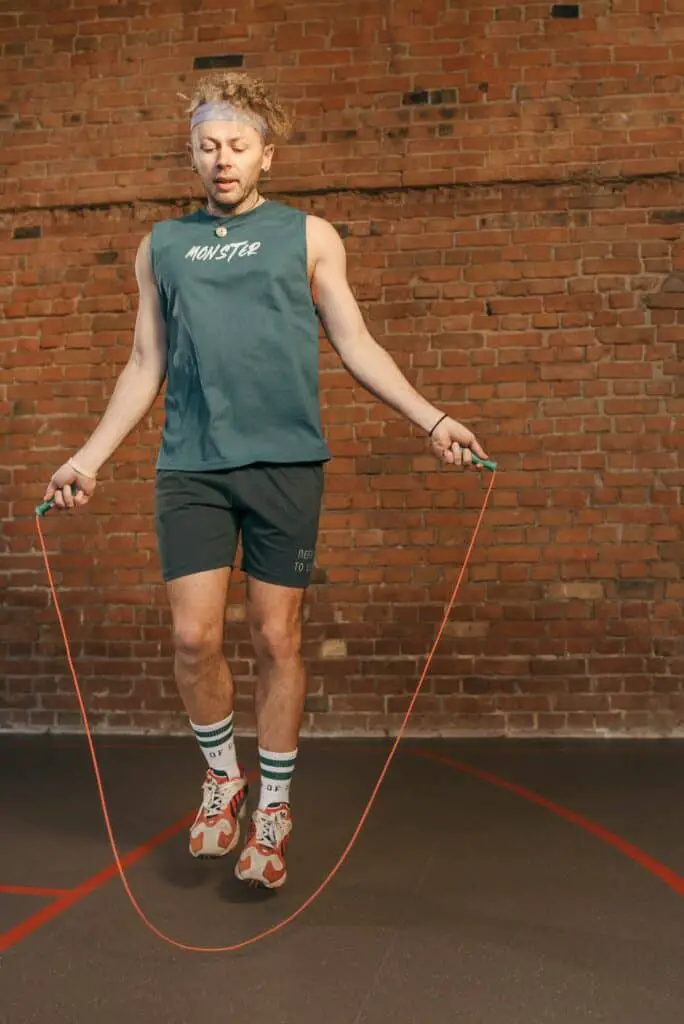
There will undoubtedly be some readers out there who have poured through our top five reviews and know with absolute certainty which one to buy.
Then, of course, there will be others who haven’t yet quite made their mind up or perhaps have even decided that none of our selections are quite right, and thus they’d prefer to look elsewhere.
If you fall into the latter camp, the following buyer’s guide may prove helpful.
Below, we’ve outlined the most important factors that we considered when picking our top five, explaining exactly why these factors are important and why you may need to take them into consideration when choosing the best rope for you.
Weight
Finding a CrossFit jump rope that is just the right weight for you and your workout should always be a top consideration.
Too heavy, and the whole thing slows down, seriously disrupting your performance in the process.
Too light, however, and that rope just won’t move the way you want it to and may be too difficult to control.
That’s why we typically went for ropes that weighed in at 1 lb or under (the ideal weight for a speed rope is under 2 lb) as these are heavy enough to ensure you can perform those double-unders effectively while at the same time not being so heavy that they slow you down.
Rope Thickness
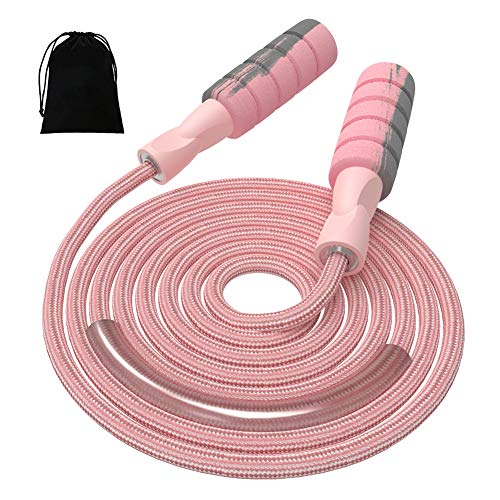
Along with the weight, the thickness of the rope cable also makes a major difference in how fast you can perform your double-unders.
As a general rule, the thicker the rope, the slower it’s going to be.
Not that this is always necessarily a bad thing.
If you’re just starting to use jump ropes in your CrossFit training, or if you’re looking for the ideal option for general resistance training, a thicker cable might be just the thing.
However, if you’re a seasoned CrossFitter focussed on speed, then yes, the thinner, the better.
Rope Length
It probably goes without saying that not all jump ropes are made equal.
Some extend to over 10ft, many keep it around the 9ft region, and some are even smaller still.
Why does this matter?
Simple:
If your rope is too short, you’re going to either trip over it, crack it against your head, or both while you try to use it.
If it’s too long, it’s only going to crack against the ground when you try to move it and will be too long, heavy, and cumbersome to work with properly.
With that in mind, it’s worth paying attention to the height and look for one that is around a foot longer than your height.
Sure, almost all ropes can be adjusted by detaching them from the grips and cutting them at the appropriate point with a pair of pliers, but life is generally so much easier if you don’t have to go to that trouble.
Handles
We mentioned in the introduction to this article that comfort was one of the most important factors we took into consideration, and the grip plays a major part in that.
At a bare minimum, you’re going to want to find a CrossFit jump rope with sweat-resistant handles so that even if your hands do get plenty sweaty, it’s not going to cause you to lose your grip.
Beyond that, you may also want to pay close attention to the quality of the material used on the grips, as something soft and supporting like memory foam sponge or nylon is always going to be more comfortable than something cold and unforgiving like steel.
On a final note regarding the handles, if you think you may need to adjust the length of your rope for any reason, it’s worth considering how easy it is to detach and reattach those handles so that you can easily trim the rope to the appropriate length.
Quality And Durability
Finally, let’s not forget that jump ropes used for CrossFit take a serious beating.
The rope itself may be constantly hitting the floor, meaning the cable has to be remarkably strong to avoid it becoming damaged, while one drop to the ground can cause handles on lesser-quality ropes to become damaged completely.
As such, quality and durability should be an essential factor when you’re choosing the right jump rope for you as even though most ropes aren’t the most expensive pieces of CrossFit equipment out there, many can still cost a pretty penny, and the last thing you want to do is to find yourself replacing them regularly.
On a related note, we should also point out that many skipping ropes don’t exactly perform well outdoors on surfaces such as concrete, nor is it recommended to use them on hardwood flooring as the cables can become easily frayed and eventually rendered unfit for purpose.
Frequently Asked Questions About CrossFit Jump Ropes
What Length Should My CrossFit jump Rope Be?
To prevent injury and ensure proper running form, your CrossFit jumping rope should allow for roughly 6″ – 12″ of space between the top of your head and the rope as you use it.
What Is The Point Of A Speed Jump Rope?
As the name implies, speed jump ropes are designed to ensure the rope can move quickly under your feet two or three times with each jump, ensuring a more intense workout.
What Muscles Does A CrossFit Jump Rope Work?
Working out with a jump rope helps to strengthen your glutes, quads, and calves while also engaging your core, arms, and shoulders too.
What Jump Rope Do They Use In Crossfit?
Most CrossFitters tend to opt for speed ropes to perform fast and efficient double-unders, though weighted ropes can also prove popular for upping the intensity and building muscle.
What Are The Best CrossFit Jump Ropes To Buy In 2021? Our Verdict
Truth be told, each one of our top five picks could reasonably claim to be the very best CrossFit jump rope as each one has plenty to offer in terms of quality, comfort, and performance.
Yet knowing that doesn’t exactly make it any easier when it comes to determining which one of the five is the right one to spend your money on.
With that in mind, let’s wrap things up today with a few final recommendations.
If keeping your costs down is what matters most to you right now, then you’ll love our top budget pick, the Cordforce Tangle-Free Jump Rope is undoubtedly the one to go for as it comes in at an exceptionally low price despite offering all of the lasting-durability of a much more expensive model, as well as being effortlessly easy to adjust and offering memory foam handles for better grip and all-round comfort.
If you’re deadly serious about taking your CrossFit to the next level so that you can compete with the best in the sport, then it absolutely has to be the Froning SR-1F Speed Rope 2.0, a high-quality, high-performance jump rope developed by the leading CrossFit brand Rogue Fitness in collaboration with CrossFit star Rich Froning Jr.
However, if your goal is to simply get the best CrossFit jump rope money can buy to help you improve your workouts and engage core muscle groups effectively, then we definitely recommend the Crossrope Get Lean Weighted Jump Rope Set, a lightweight twin-set of weighted ropes that are a cut above just about anything else out there right now.
